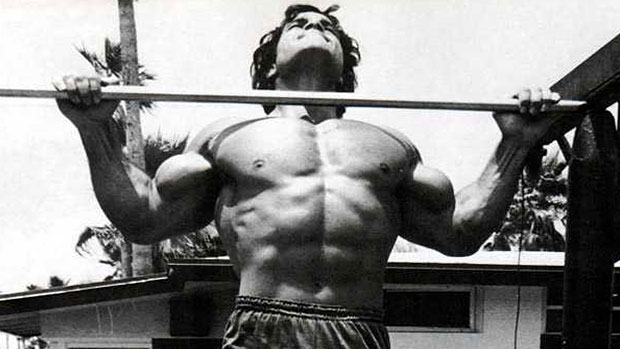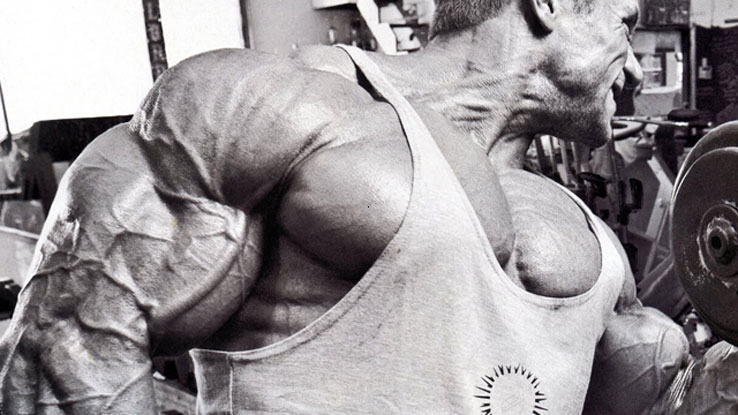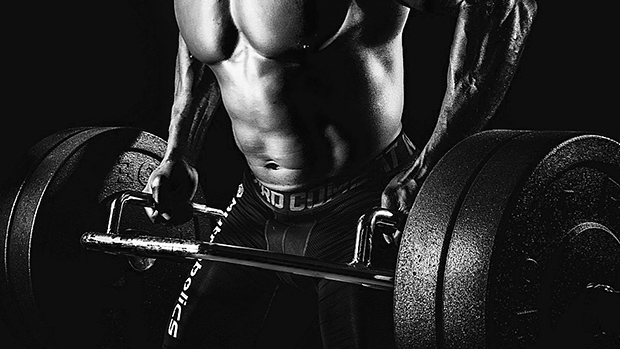You can't really consider yourself fit if you suck at pull-Ups. That's just the way it is.
Think of the fittest, baddest looking sumbitches at your gym: do they bang out sets of 10 or more lat-stretching pull-Ups, often with a couple chalk-dusted plates chained to their waist? Or do they struggle to perform even just one anemic rep before sulking over to the assisted chin machine?
I suspect that if it's the latter, your opinion of their overall badassery would quickly diminish.
Those of you that suck at pull-Ups today have likely sucked since birth, and can likely recall the humiliation you experienced during pull-Up day in gym class, when all you could do was hang from the bar and twitch spastically for a few awkward seconds before falling to the floor in a shameful, tear-stained heap.
To alleviate that problem for future generations, most schools have since removed the pull-Up from their Physical Education programs, replacing it with the flexed-arm hang, plank variations, or calculator races – or simply removed PE class altogether.
Thank God they ditched the pull-Up. It's important that we teach the leaders of tomorrow that when presented with a seemingly insurmountable challenge, you need only to cry to your parents about how unfair life is, so said challenge can be reduced, removed, or replaced with something else that doesn't have callous-building potential.
Besides, it's not like anyone will ever need to pull him or herself up in real life, right?
End that rant.
The 800-Pound Gorilla With A Fanny Pack
Before I get to the meat of this article, I'd be remiss if I didn't address the 800-pound gorilla in the room (no, not your mother-in-law) – a HUGE component to any pull-Up challenge is total bodyweight.
Regardless if you're 300 pounds of donuts and Kashi or 300 pounds of striated muscle, all that extra weight is going to make performing the pull-Up more challenging.
Obviously, dropping body fat never fails to drive pull-Up numbers sharply – so if your V-shape looks more like a big 'O' and you want to bang out pull-Ups like a seasoned Marine, it would be a wise move to first drop some chunk. I doubt few lifters would argue with that statement.
But it's the other side of the bodyweight argument that really ticks me off. If I have to hear that weak sauce cop-out, "It's because I'm so big and muscular that I can't do pull-Ups to save my life," I might just blow a gasket. You're pissing on my leg and trying to convince me it's raining. It's not working.
Check out the video of Konstantinovs, a powerlifter, doing about 55 pull-Ups with fairly decent form – at a bodyweight of nearly 275-pounds.
Despite being a freak, Konstantinovs is definitely not alone. I can think of dozens of big, jacked guys that can bang out Pull-Ups with abandon, as well as dudes in the 180-220 pound range that can kill it with an extra 50-100 pounds strapped to their waist.
So your excuse, big guy, is no excuse at all.
No Pull-Ups? Other Issues
When you can't do any pull-Ups at all, you likely have more issues than Windows ME but fear not, we can still make progress.
The first problem area is strength, or lack thereof. You don't have the necessary strength to pull your own bodyweight up, so it's obvious that you need to get stronger.
The primary muscles working in the pull-Up are the lats, biceps, and rear deltoids, with numerous synergists including the forearm flexors, elbow flexors, rhomboids, teres major, external rotators, and trapezius; even the core and legs, to a lesser degree.
Of course, one of the best ways to strengthen these muscles is to do pull-Ups, but obviously that isn't one of your options. Other exercises we'll be focusing on are 45-degree bent over rows, dumbbell rows, lat pulldowns, and then some specific pull-Up related exercises.
I like the lat pulldown as a gauge of pull-Up strength potential. The general guideline I use is if you can lat pulldown 75% of your bodyweight or more for 1 rep, then you're close to being able to do one real pull-Up.
Pull-Up Technique
As with all lifts that involve some skill, the technique on a pull-Up is important. (Here is a demo of a strict pull-Up.)
Most people know the basics, but the key to mastering pull-Ups (or just to stop sucking at them) is to learn how to kip properly.
A kip is when you use some other muscles and momentum to perform the pull-Up. I can picture the CrossFit-phobes snorting into their protein shakes when I mention the kip, but first you have to realize that there are two types of kips: conditioning kips and controlled kips.
Conditioning kips are when all you care about is getting the chin up over the bar at all costs – and to accomplish this you use every ounce of lower body momentum at your disposal. That's definitely not what I'm talking about.
A controlled kip is a relatively subtle movement that involves some power generation in the legs and hips, where that power is then transferred to the upper body.
Make no mistake, it definitely makes the exercise easier, but if you can't do any strict pull-Ups at all (or hardly any), it's best to use the controlled kipping variety, at least for the time being.
In a few months you'll be able to perform strict, clean pull-Ups thanks to the strength built from performing controlled kip pull-Ups.
What's A Good Kip?
A good kip is a little hard to explain (see video below) and when you're first learning the technique it'll feel a bit exaggerated. Once you get more proficient, your kip will become more subtle.
When I'm ready to do pull-Ups, I usually bend my knees a bit, cross one leg over the other, and then go.
- The first part of the kip is a slight raise of the legs (hip flexion). The knees should absolutely not go higher than the hips and in many cases they just move up 10-20 degrees; but when you're learning you'll lift the legs up higher than that.
- The movement needs to lead into a near-instant transition into a hip thrust, where you try to use some of your biggest muscles in your body (glutes and upper hams) to do some hip and trunk extension. It's a little like the pull in a hang clean; the hips thrust forward and that propels the upper body upward. Again, when learning it feels more exaggerated, becoming subtler as experience and power increase.
- The chest should be up as you pull yourself up to the bar. I think of trying to pull my upper chest to the bar – your chest may not literally hit the bar, but thinking "chest up" can help with form. Often when people think "chin above the bar," they round forward and protract at the end to jut their chin forward, which is not the position we're looking for. You want to keep the chest high and tall, with the shoulders down and back. In looking at the trunk (not the arms), the finish position of a pull-Up is actually similar to the finish position of a heavy curl or deadlift.
- When you perform a kip right, the exercise will feel a bit easier, and that's what we're after. Don't worry about "squeezing the lats" or anything; they'll get enough stimulation from the exercise itself. Our goal is performance, not size.
So when you do it right and feel yourself shoot up to the bar, try to remember that and duplicate it every rep.
The Exercises
- Pull-Up: Using a pronated grip, start with the arms extended and pull yourself up so your chin is above the bar. Compared to the chin-Up, pull-Ups place more emphasis on the rear delts, mid back, brachialis, and brachioradialis. It's generally considered harder than a chin-Up.
- Chin-Up: Using a supinated grip, start with the arms extended and pull yourself up so your chin is above the bar. Compared to the pull-Up, chin-Ups place more emphasis on the lats and the biceps. It's generally considered easier than the pull-Up.
- Flexed-Arm Hang: Get your chin above the bar and hold that position for a set time. The grip is normally supinated but can be pronated.
- Negatives: Get your chin above the bar and then lower yourself back down until your arms are straight, attempting to keep control of your body at all times. Generally, negatives are 6-10 seconds in length.
- Jumping Pull-Ups: Perform a pull-Up, but start off with a jump; this makes it easier and generates more momentum. Return to the ground and jump at the beginning of each rep. When done repeatedly this can create a significant conditioning effect.
- Kipping Pull-Ups: As previously described this involves using some momentum to do a pull-Up. This is in contrast with a strict pull-Up (legs immobile, full stop at the bottom, full range of motion).
- Partials: Get your chin above the bar and then lower yourself down as low as you can without losing the ability to come back up. In short, anything less than full range of motion is a partial, and the shorter the range of motion, the easier it is.
- Band Assisted Pull-Ups: Loop a band around the pull-Up bar and place the other end around your foot or knee. The band will help you Pull-Up to the bar, thus making the lift easier. Bands provide more help at the bottom than at the top, and if placed around the foot provide more help than if placed at the knee. Using a mini, light, or average band is most common (or a combo of the above). This is an ideal substitute to the partner-assisted pull-Up if you don't have a partner.
- Partner Assisted Pull-Ups: Cross your legs and have your partner hold your feet pressed up against his upper thigh. He's not lifting you, he's keeping his hands stable. You press against him (perform a leg extension) to push yourself up; thus you can regulate how much help you need. The more tired you are, the more you push.
A method of progression is to just hold one leg instead of both. Your partner doesn't need to be very strong to do this unless you're very heavy.
This is one of the best ways to learn how to do a pull-Up.
Please note that the assisted pull-Up machine (where you stand on a platform and pull yourself up) is near useless for learning how to do pull-Ups, so do NOT perform that exercise.
The Programs
Before I present you with a few strategies to get you on the road to pull-Up success, we first need to determine what category of pull-Up suckery best describes you:
- Category 1 is if you can't do any pull-Ups at all.
- Category 2 is if you can get 1-4 decent pull-Ups.
- Category 3 is if you can do 5-9 pull-Ups.
To be fair, you probably don't suck at pull-Ups if you can do more than 5 with good form – and if you're a female, that's actually pretty good – but you can still get better.
Category 1: The "I really, really suck" program
- Target Audience: Zero Pull-Ups
- Frequency: 2 times a week, spread out by 2-3 days each
Day 1
- Negative Chin-Up 4 x 2-3
- 45-Degree Bent Over Row 4 x 10, 8, 6, 12
- Wide Grip Pulldown 3 x 12, 10, 8
Day 2
- Flexed-Arm Hang 4 x 15 seconds
- Assisted Pull-Up 4 x 8-12
- Dumbbell Row 3 x 10, 8, 6
Optional
- Train biceps 1-2 x week, often at the end of this program. Go moderately heavy.
- Forearms can be trained if grip is an issue.
- Do a 5-second negative, 1 jumping pull-Up OR a 10-second flexed-arm hang as frequently as you wish.
Progression
- For the negatives, work on being in control throughout the ROM and not just at the top.
- For the flexed arm hang, increase by 5 seconds when you can (usually about every 2-3 weeks).
- When you can perform your heavy set on the assistance exercises, increase all weights per set by 5 lbs.
- Test yourself every 4 weeks to see if you can do a strict pull-Up yet. It's okay to jump up and start at the top (don't count that one), lower yourself down and then try to come back up. Be sure to go at least ¾ of the way down for it to count as one rep.
Category 2: The "I kind of suck" program
- Target Audience: 1-4 pull-Ups
- Frequency: 2 times a week, spread out by 2 days of rest minimum.
Day 1
- Pull-Up w/negatives 4 x 4
- 45-Degree Bent Over Row 4 x 10, 8, 6, 15
- Wide Lat Pulldown 3 x 12, 10, 8
Day 2
- Flexed-Arm Hang 4 x 30 seconds
- Assisted Pull-Up 4 x 8-12
- Dumbbell Row 3 x 12, 9, 6
Optional
- Train biceps 1-2 x week, after your pull-Up program. Go moderately heavy.
- Forearms can be trained as well if grip is an issue.
- Do a 10-second negative, 1 kipping pull-Up, OR a 15-second flexed-arm hang as frequently as you wish.
Notes
- On day 1, use jumping pull-Ups once you can't do any more pull-Ups yourself (i.e., do 2 regular pull-Ups with the negative and then do 2 more jumping pull-Ups with the negative to get the 4 reps required).
- When the weight goes up, the reps go down. For example, a male doing the bent-over row might look like 95x10, 115x8, 135x6, 85x15.
Progression
- Each week add 1 rep to two of the pull-Ups with negatives sets.
- Each week add 5 seconds to two of the flexed-arm hang sets.
- Every other week you can do all sets/reps on the assistance exercises, increase weight by the smallest increment possible and repeat.
Category #3: The "I sorta suck" program
- Target Audience: 5+ pull-Ups
- Frequency: 3 times a week with one day of rest in between each day
Day 1
- Pull-Up 4 x 4, 4, 3, 3 reps. Rest as much as necessary, begin the workout with this protocol.
Day 2
- Weighted Pull-Up w/10 lbs 4 x 2 reps, followed by 3 negatives.
- 45-Degree Bent Over Row 3 x 12 (increase weight each set)
- Dumbbell Row 3 x 12 (increase weight each set)
Day 3
- Pull-Up 4 x 4 reps. Rest as much as necessary, begin workout with this protocol.
Notes
- You MUST learn to kip properly and that must be practiced on every rep.
- Movement can consist of regular pull-Ups or chin-Ups.
- Increase weight by about 10-20 lbs each set on the bent over row.
- Increase weight by 5-10 lbs each set on the Dumbbell row.
Progression
- Every third week add 1 rep to all non-weighted pull-Up sets.
- Every other week add 5-10 lbs to the assistance exercises and repeat.åEvery other week add 2.5-5 lbs to the weighted pull-Up.
No matter what degree of "suckitude" you currently fall in, this program has what you need to get your chubby chin over the bar. Once you can move into the next category (i.e., you go from doing 2 pull-Ups to 6), you can then begin following the prescribed training protocol for that new strength level you've achieved.
In two to three months, you should see a significant difference in your pull-Up strength, not to mention your back and upper arm musculature.
Granted, it may not erase all those painful memories of crying in the corner of the school gym, but at least you'll sleep soundly knowing that the dreaded "you suck" stigma is a thing of the past.





